Cox's Bazar, Bangladesh
A 12-year-old Rohingya refugee covers herself and her 10-month-old niece. Both go for a walk in the early morning at the Kutupalong camp to warm up from the cold inside their shelter. UNHCR/Andrew McConnell
In 2021, three other appeals are in place. The Rohingya Refugee Response - Joint Response Plan in Bangladesh, will deliver vital assistance to 889,000 refugees and 472,000 members of the host community who are in need.
It will strengthen the protection of all Rohingya refugees, foster the well-being of Bangladeshi host communities and work towards achieving sustainable solutions in Myanmar.
Other Appeals: Overview of appeals (2021)
The Regional Migrant Response Plan for the Horn of Africa and Yemen, will provide life-saving and basic needs support to over 300,000 migrants along the Eastern Route. It will offer protection assistance to both migrants and host communities and strengthen access to return.
Evolution of People in Need (2020 vs. 2021)
The Venezuela Regional Refugee and Migrant Response Plan, targets 3.3 million people, including members of host communities. It will scale-up efforts across different sectors and focus on immediate humanitarian assistance and protection activities for the region’s largest movement of refugees and migrants in recent history.
Rohingya
Analysis of the context, crisis and needs
Some 860,000 Rohingya refugees reside in 34 congested camps in Ukhiya and Teknaf upazilas4 of the Cox’s Bazar district. The humanitarian community has worked to meet the humanitarian needs of refugees and host communities throughout 2020. The operation pivoted in March 2020 to focus on emergency preparedness and response for the COVID-19 pandemic.
The Government of Bangladesh and the humanitarian community quickly mobilized to mitigate and respond to the anticipated impacts of the COVID-19 pandemic. This fast response was key, given conditions in the camps, the high levels of vulnerability among the Rohingya refugees and nearby Bangladeshi communities, and the severe strain placed on the national health-care system.

Cox's Bazar, Bangladesh
A Rohingya refugee child studies in his shelter in Kutupulong mega camp.
ISCG/Saikat MojumderActivities in the camps were restricted to critical services only. An 80 per cent reduction in the number of humanitarian workers going to the camp each day helped mitigate the spread of the virus. However, the reduced humanitarian footprint restricted the delivery of essential assistance and contributed to a deterioration in the protection environment, exacerbating the vulnerabilities of women, children, older persons and those with disabilities. The Rohingya crisis reflects trends seen around the world during the pandemic: GBV, violence against children and negative coping mechanisms have increased. Child labour, child marriage, trafficking and dangerous onward movements by boat have also risen.
Cox’s Bazar is among the country’s poorest districts, with a total Bangladeshi population of more than 2.6 million. Over the last three years, the Rohingya refugee presence has compounded existing challenges. The massive humanitarian operation has increased employment and economic opportunities, but Bangladeshi host communities have faced adverse consequences for their food security, livelihoods and nutritional status, particularly in Ukhiya and Teknaf upazilas, where the camps are located. Humanitarian and development initiatives have begun to address these impacts in Cox’s Bazar district, but COVID-19 has stretched the capacities of communities and Government institutions, impacting Rohingya refugees and Bangladeshis living nearby.
Projected situation in 2021 and beyond
The humanitarian response is now moving into its fourth year following the massive influx from Myanmar. Rohingya refugees will continue to rely on humanitarian aid to meet their basic needs until durable solutions are possible. The humanitarian community will provide life-saving assistance to Rohingya refugees within a solid protection framework, whil also working to create conditions conducive to voluntary return to Myanmar. In 2021, sustained and strengthened assistance across multiple sectors will be required in areas including food, nutrition, safe water and adequate sanitation, shelter, and access to health care and education for Rohingya refugees and nearby Bangladeshi communities.
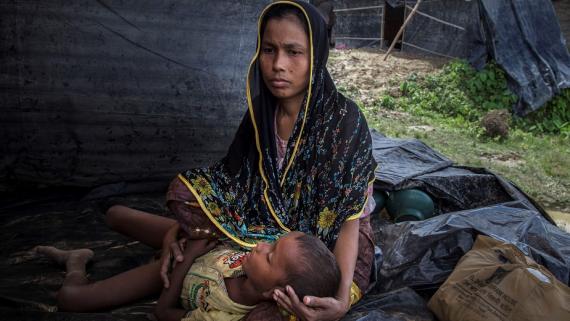
Cox's Bazar, Bangladesh
This Rohingya refugee mother has nursed her son under plastic tarpaulin for the last three days. He’s had bad diarrhoea and fever and isn’t holding down any food. “When he wakes up he’s crying all the time. Something really bad is going on with him,” she says worriedly. She arrived at the camp with her five sons and one daughter. She says she left her village because people were shooting and setting their houses on fire.
UNICEF/LemoyneThe uncertainties of the global COVID-19 pandemic compound the already overwhelming sense of insecurity and trauma faced by Rohingya refugees. The humanitarian community is concerned by an evident deterioration in the overall protection and security environment in the camps, which stems in part from necessary COVID-19-related restrictions on the delivery of essential services and assistance. These are likely to persist into 2021.
Addressing the specific needs of women, girls and vulnerable groups will be critically important. Once the public health situation stabilizes, reopening temporary learning centres and resuming educational programmes will be a key priority to ensure the well-being of refugee children and youth. In nearby host communities, the loss of livelihoods, the breakdown of food production and market systems, and the worsening of food and nutrition indicators will remain challenges next year. The social impacts of the pandemic and increased competition over livelihoods could further undermine cohesion and peaceful coexistence between refugees and host communities.
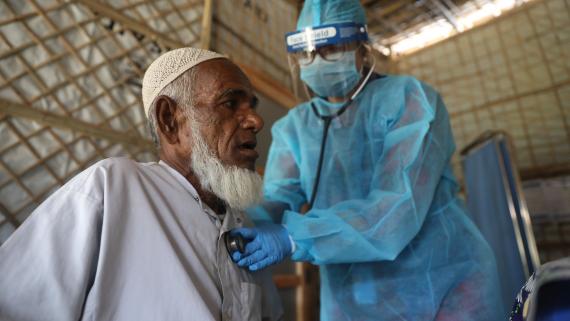
Cox's Bazar, Bangladesh
An older patient is checked by a doctor at a refugee camp in Cox's Bazar. IOM is supporting medical care for Rohingya refugees in Bangladesh.
IOM/Abdullah Al MashrifRohingya refugees and local Bangladeshis will continue to be highly vulnerable to the impacts of cyclones and monsoon winds and rains. Regular improvements to shelters have been limited during the COVID-19 pandemic. Frequent heavy rains have contributed to the deterioration of shelters in the refugee camps, and the use of more durable materials is needed to ensure the safety and sustainability of households, particularly during the monsoon and cyclone seasons. Building on Bangladesh’s well-established and effective disaster response capacities, the Government and humanitarian partners will work to mitigate risks, enhance community resilience to shocks, and ensure adequate contingency planning and preparedness for cyclones and monsoons.
Response priorities in 2021
The humanitarian community, including NNGOs, INGOs and UN agencies, working across sectors and in close coordination with the Government of Bangladesh, will continue to improve protection and assistance standards for Rohingya refugees and their host communities in the Teknaf and Ukhiya upazilas of Cox’s Bazar. Four strategic objectives will guide the response in 2021 following the pathway established this year:
- Continue to strengthen the protection of Rohingya refugee women, men, girls and boys.
- Deliver quality, life-saving assistance to populations in need.
- Foster the well-being of Bangladeshi host communities in Ukhiya and Teknaf upazilas.
- Work towards achieving sustainable solutions in Myanmar.
Rohingya and Bangladeshi volunteers on the frontline of the COVID-19 response

The first case of COVID-19 was confirmed in the Rohingya refugee camp in mid-May. In response, a temporary reduction in the humanitarian footprint was introduced to minimize risk of virus transmission. Thousand of Rohingya refugees and Bangladeshi volunteers served as critical first responders to the pandemic, carrying out life-saving activities under the 2020 JRP and COVID-19 Response Plan. Beyond supporting essential programmes, such as emergency preparedness, water and sanitation, and site development works, Rohingya and Bangladeshi volunteers served as community health workers and provided critical support to COVID-19 treatment facilities, which catered to both communities.
Humanitarian partners, including community-based organizations, provided training on life-saving COVID-19 prevention and response messages and actions, which thousands of volunteers then disseminated in Rohingya, Burmese and Bengali languages across all 34 camps in Ukhiya and Teknaf, and adjacent Bangladeshi communities. Volunteers on the front lines of the emergency response also connected women and girls to safe spaces and shared GBV prevention and referral messages to mitigate the risk of domestic violence and abuse. "Knowing that my work is reducing even a small bit of their suffering is the best reward that I can ask for," says a 22-year-old female Bangladeshi volunteer who supports the host and Rohingya communities.
The picture shows a Rohingya volunteer cyclist before his shift. He has a megaphone to deliver key COVID-19 and MHPSS messages to the community.
IOM/Mashrif Abdullah AlA protection framework that recognizes critical protection issues, foresees targeted protection activities, and commits all humanitarian partners to protection and gender mainstreaming will guide the response for Rohingya refugees. It will be implemented in full partnership with the Government of Bangladesh and affected populations.
The humanitarian response will focus on improving living conditions for Rohingya refugees. This includes access to education through the Myanmar Curriculum Pilot and skills development, as well as upgrading shelters and learning facilities to two-storey structures. Another key focus will be enhancing systems for community representation in the Rohingya refugee camps, AAP and promoting social cohesion.
Humanitarian actors will support the Government in strengthening public services and delivery for vulnerable communities in Ukhiya and Teknaf, the areas most affected by the presence of Rohingya refugees. They will also support development planning in Cox’s Bazar district and work to achieve synergies between humanitarian and development assistance.
Further reading
Source: ISCG Bangladesh
Source: Financial Tracking Service
Horn of Africa and Yemen
Analysis of the context, crisis and needs
Migration from the Horn of Africa along the Eastern Route to Yemen and beyond remains the world’s busiest maritime route. In recent years, thousands of migrants, travelling mainly from Ethiopia and Somalia through smuggling networks, have transited through Yemen each year, with some travelling via Djibouti to the Kingdom of Saudi Arabia. An estimated 160,000 migrants arrived in Yemen in 2018 and over 138,000 arrived in 2019. The migrants are mostly Ethiopian (93 per cent) and Somali (7 per cent). They are mostly young men or boys with low levels of education, migrating due to destitution, disparities and/or conflict in their areas of origin, and often seeking economic opportunities.
In 2020, COVID-19 brought new challenges and risks for migrants travelling the Eastern Route. The pandemic prompted Governments in the Horn of Africa and the Gulf to impose stringent border closures, increase movement restrictions and tighten security along known migratory routes. This made the already dangerous and difficult journey even more perilous. The movement restrictions impacted migrant flows, with just 33,122 new arrivals recorded in Yemen between 1 January and 30 September 2020, representing a decrease of 69 per cent compared to the same period in 2019.
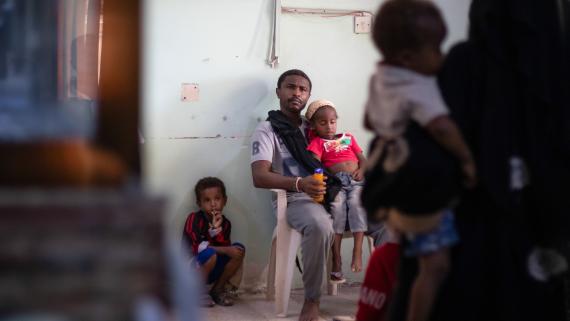
Aden, Yemen
A father and his two children wait to get blood tests at Al-Basateen health centre. The centre is supported by UNHCR and KSrelief.
OCHA/Aiman FuadIncreased movement restrictions within countries and the forced transfers of migrants have also resulted in migrants becoming stranded along the route. They have no access to essential services, they are exposed to smugglers, abuse and exploitation, and they face increased risks of contracting COVID-19 as well as other threats to their health and well-being. As of October 2020, 14,500 migrants were stranded in Yemen, 1,200 in Djibouti and over 900 in Somalia. At the same time, continued returns from Yemen and Saudi Arabia have been observed, with over 82,000 recorded, including spontaneous returns (47,000) and forced returns (35,000) to Ethiopia between January and October 2020. However, total return figures are estimated to be much higher.
Throughout their journey, migrants face extreme protection risks, including violence, trafficking, abduction, forced labour, exploitation, detention and GBV. They risk death while crossing the Bab-el-Mandeb strait and the Gulf of Aden, and exposure to conflict as they pass through Yemen. In 2020, at least 51 migrants died on the Horn of Africa route. The most recent deaths were in October 2020: 20 migrants were found dead, with others missing, off the coast of Djibouti while crossing the strait. In 2019, at least 123 migrants were killed or went missing along the route, with an estimated 60 migrants killed in air strikes in Sa’ada, Yemen. Numbers of deaths are lower in 2020 due to reduced migration along the route, but an average of 159 people have died annually on the route since 2014, with the real number estimated to be higher. While these risks affect all migrants taking on this dangerous journey, women and girls are at heightened risk of GBV, and unaccompanied children are at greatest risk of harm.
Projected situation in 2021 and beyond
Needs in 2021 are expected to be exacerbated due to the increased number of migrants stranded across the Eastern Route due to COVID-19-related movement restrictions and border closures. More so, the reopening of borders, and the negative impact of COVID-19 on income and livelihoods in countries of origin, will mean that the number of persons opting to migrate in search of better opportunities will be on par with or more than the numbers in 2019. The needs of host communities in areas of return or where migrants are transiting through, stranded or settled are expected to increase as more people compete for reduced resources and access to services. As borders reopen and restrictions are slowly lifted, migrants stranded in Djibouti, Somalia or Yemen are expected to resume their journeys or attempt return to their countries of origin due to lack of resources and difficulties faced while stranded. It is anticipated that those who decided to migrate but were unable to due to the pandemic will start their journeys in 2021, particularly as COVID-19 will have exacerbated poverty and unemployment in areas of origin, contributing towards the decision to migrate despite increasing difficulties along the route.

Aden, Yemen
A couple of young Somali refugees are greeted by a humanitarian worker as they arrive at the Aden sea port.
OCHA/Mahmoud FadelMigrant flows in 2021 are expected to be similar to 2019, with 1.7 million people projected to be impacted and 763,184 people projected to be in need of humanitarian assistance (including 352,610 migrants and 410,574 host/returnee community members). This includes transiting migrants, stranded migrants, migrants at destination, returnees, host communities (at areas of origin and in areas where migrants are transiting, stranded, at destination), as well as families of those who have migrated. Some 86 per cent of all migrants transiting are expected to be in need, whereas 100 per cent of stranded migrants will be in need due to their situation.
Response priorities in 2021
The 2021 Migrant Response Plan (MRP) targets 563,128 persons out of a total of 763,184 PiN (including 251,329 migrants and 311,799 host/returnee community members). Note that overlaps with HRPs are avoided by adjusting people in need, people targeted and requirements.
This will require partners to ensure that assistance to migrants is balanced with that of host communities. Under the MRP partners will:
-
Provide life-saving assistance to vulnerable migrants and host communities.
-
Build evidence, partnerships and coordination to enhance the humanitarian response and migration management throughout the migration route.
-
Strengthen access to return, sustainable reintegration and community stabilization.
-
Provide quality, timely and inclusive protection assistance and services to migrants and host communities.
The migrant response will focus on life-saving and basic needs support along the route via mobile teams and the establishment of Migrant Response Points and Child Protection desks, and at waystations. Protection services will be prioritized, including strengthening child protection services, referral mechanisms and establishing additional standard operation procedures. Assistance to vulnerable host communities will be provided through similar response modalities.

Karaz Refugee Camp, Yemen
A Somali refugee is pictured waiting her turn to receive cash payments at the Karaz Refugee Camp, in Lahj governorate.
OCHA/Mahmoud FadelPartners will also support the capacity-building of Governments to improve assistance to migrants, and in the development of policies and laws to improve migrants’ rights and migration management. Community-based resilience and economic empowerment activities targeting hotspots of migration and areas of return will be key to addressing some of the root causes of migration and help to build synergies between humanitarian and development activities. A regional approach will focus on strengthening the evidence base at the same time as fostering an environment of cooperation and agreement between Governments and among partners, with the objective of upholding international standards and norms to protect and assist migrants. This approach will go hand in hand with the in-country responses.
Further reading
Source: IOM
Source: IOM
Source: Financial Tracking Service
Venezuela Regional
Analysis of the context, crisis and needs
The political, human rights and socioeconomic developments in the Bolivarian Republic of Venezuela have led to the largest movement of refugees and migrants in the recent history of Latin America and the Caribbean. As of November 2020, of the approximately 5.5 million refugees and migrants from Venezuela displaced globally, some 4.6 million are hosted in the region alone, including an estimated 1 million with an irregular status. Despite the devastating and ongoing socioeconomic and human impact of COVID-19, countries in Latin America and the Caribbean have continued to show great solidarity towards Venezuelans, facilitate access to basic rights and life-saving services, and support their integration. However, the already precarious situation of many refugees and migrants from Venezuela and affected host communities is reaching alarming levels. National and local capacities have been dangerously strained due to the continued impact of COVID-19 in Latin America and the Caribbean, threatening the overall social fabric in the 17 countries covered by the regional Refugee and Migrant Response Plan (RMRP).

Manaus, Brazil
A Warao family from Venezuela at a shelter in Manaus, Brazil, where they were relocated amid the COVID-19 pandemic. The measures taken to mitigate the pandemic have significant consequences for the protection, health, socioeconomic welfare and resilience of forcibly displaced and stateless people and their host communities.
UNHCR/Felipe IrnaldoSome countries have included Venezuelans in social welfare programmes put in place during the pandemic, but there is a need for R4V partners to significantly scale-up efforts to assist people in increasingly precarious situations. In a region characterized by high levels of informal labour, the implementation of measures aimed at curbing the spread of COVID-19 (including border closures, lockdowns, curfews and other quarantine measures) has had a disproportionately grave impact on refugees and migrants. Without savings or alternative social safety nets, many people are unable to cover basic needs or access vital services due to the loss of employment.
Halted or limited movements between borders have reduced the ability of refugees and migrants to regularly enter and stay in some countries in 2020. This has resulted in increased irregular border crossings and exposure to protection risks. The deteriorating economic and social situation in many countries resulted in some refugees and migrants considering return, often through irregular channels. This has raised additional protection and health concerns. At the same time, increasing numbers of re-entries to neighbouring countries were noted towards the end of the year.
Projected situation in 2021 and beyond
In 2021, movements of refugees and migrants in the region, including through irregular channels, are expected to continue despite the lasting impact of the COVID-19 pandemic, potential restrictions at border crossings, and/or lack of opportunities to regularize their stay in countries of destination. People in such irregular situations will remain highly vulnerable to exploitation and abuse, including violence, discrimination, smuggling and trafficking.
Due to the complex economic and political outlook, increased dependency on emergency humanitarian assistance in the areas of health, shelter, food, protection and access to education is reflected in the increased needs outlined in the 2021 RMRP.
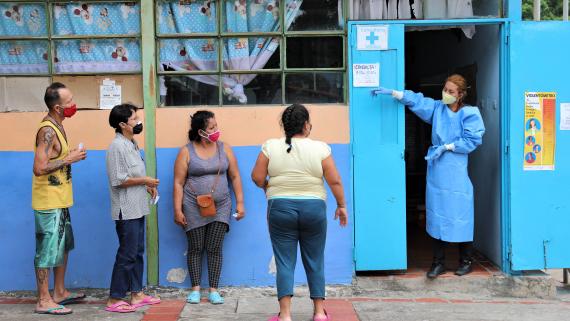
Guasdualito, Venezuela
A doctor shows a group of returnees the way to a temporary shelter while they wait to be consulted. Thousands of Venezuelan migrants are returning home from neighbouring countries amid the pandemic. To support the COVID-19 response, the humanitarian community scaled up its assistance, providing affected people with water and sanitation services, livelihood assistance and medical supplies.
OCHA/Gemma CortésThe COVID-19 pandemic has resulted in a dramatic increase of reported cases of GBV and mental health needs, leading to widespread food insecurity, rising levels of malnutrition and growing destitution, especially among the most vulnerable people, namely unaccompanied and separated children, single-headed households, women and girls at risk of GBV and trafficking, the elderly, those with chronic diseases, the LGBTQI+ community and those in irregular situations.
Xenophobia and stigmatization are on the rise, often based on negative perceptions associated with fear of spreading the virus and rising rates of evictions and homelessness, leading to a vicious cycle of irregularity, vulnerability, destination and stigmatization.
Response priorities in 2021
The Venezuela RMRP 2021 will address the identified needs through significantly scaled-up efforts across its different sectors. It will maintain a balance between responses, focusing on immediate humanitarian assistance and protection activities that bridge the humanitarian-development-peace nexus by responding to the longer-term resilience and integration needs of affected populations and host institutional communities. As such, the RMRP 2021 is the result of an intra-regional, field-driven strategic planning process, bringing together 158 appealing organizations in consultation with all host Governments, local communities and authorities, civil society and faith-based organizations, the Red Cross Movement and the donor community, as well as consultations with refugees and migrants from Venezuela.
The Regional Inter-Agency Coordination Platform (R4V) is convened by UNHCR and IOM to coordinate response efforts across 17 countries of Latin America and the Caribbean. In 2021, it will further strengthen coherency and consistency throughout the response. The response is reflective of the diverse thematic needs and response objectives, and it is structured across nine regional sectors with the additional support of six working groups, all led by different NGOs and UN agencies that will continue providing strategic sectoral leadership in 2021.
Focus on the environment
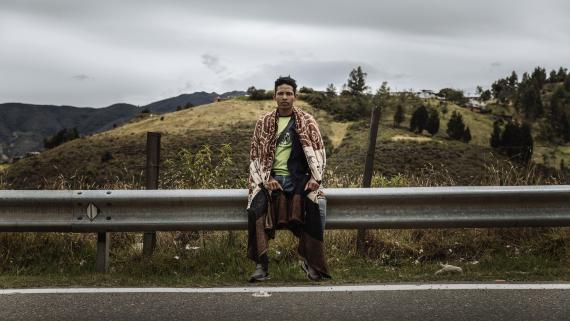
The RMRP for the Venezuela situation is the first of its kind to integrate the cross-cutting theme of the environment into its regional response. Building on the 2020 experience, this is developed through sectoral analysis using an environmental lens. This helps determine environmental problems faced by refugees and migrants from Venezuela, as well as the environmental impact of the response. Building on thematic guidance notes developed by the Regional Platform's Environment Focal Point, it has been a requirement for all R4V partners to complete an environmental self-assessment as part of their participation in the RMRP, and it will be complemented by environmental assessments throughout the year. This focus is part of a wider incorporation of key cross-cutting themes throughout the work of the Regional Platform jointly with mainstreamed considerations for PSEA, AAP, Gender and Centrality of Protection. In the picture, a caminante treks along a public road. Many make this journey with just a light jacket, rubber flip flops and a small backpack with the most essential items they manage to carry.
IOM/Muse MohammedComplementing the work of the Regional Platform, dedicated local coordination mechanisms (eight National and Subregional Platforms) will collaborate with host Governments on the operational coordination and implementation of the RMRP. These National and Subregional Platforms are in place in Brazil, Chile, Colombia, Ecuador and Peru at the national levels, and in the Caribbean, Central America and Mexico and Southern Cone at the subregional levels. Their sectoral configuration is tailored to the situational context and operational capacities of Governments and RMRP partners, taking into account existing coordination structures as well as needs of refugees and migrants in the specific context.
In 2021, the RMRP seeks to complement and further strengthen the national and regional responses of Governments, including specifically the Quito Process as the main technical regional intergovernmental coordination forum in which key policies towards refugees and migrants from Venezuela are discussed and adopted.
Further reading
Source: IOM/UNHCR
Source: Financial Tracking Service
References
- Population figures for Bangladesh JRP include refugees, as well as impacted members of host community. Refugee population figures are estimates, calculated using October 2020 figures from ongoing joint Government of Bangladesh-UNHCR registration exercise as well as an estimated number of persons not able to be registered in the course of 2020, due to a slow-down in registration activities during the COVID-19 pandemic. Total population figures will be adjusted during 2021 once registration activities fully resume.
- The people in need figure corresponds to refugees and migrants from Venezuela in destination (PiN: 3.8M / target: 2.3M), in pendular movement (PiN: 992k / target: 188k) and Colombian returnees (PiN: 625k / target: 174k), as well as host communities (PiN: 1.7M / target: 660k). For additional information concerning refugees and migrants from Venezuela in transit (PiN: 285k / target: 212k), please see the Regional Refugee and Migrant Response Plan (RMRP).





